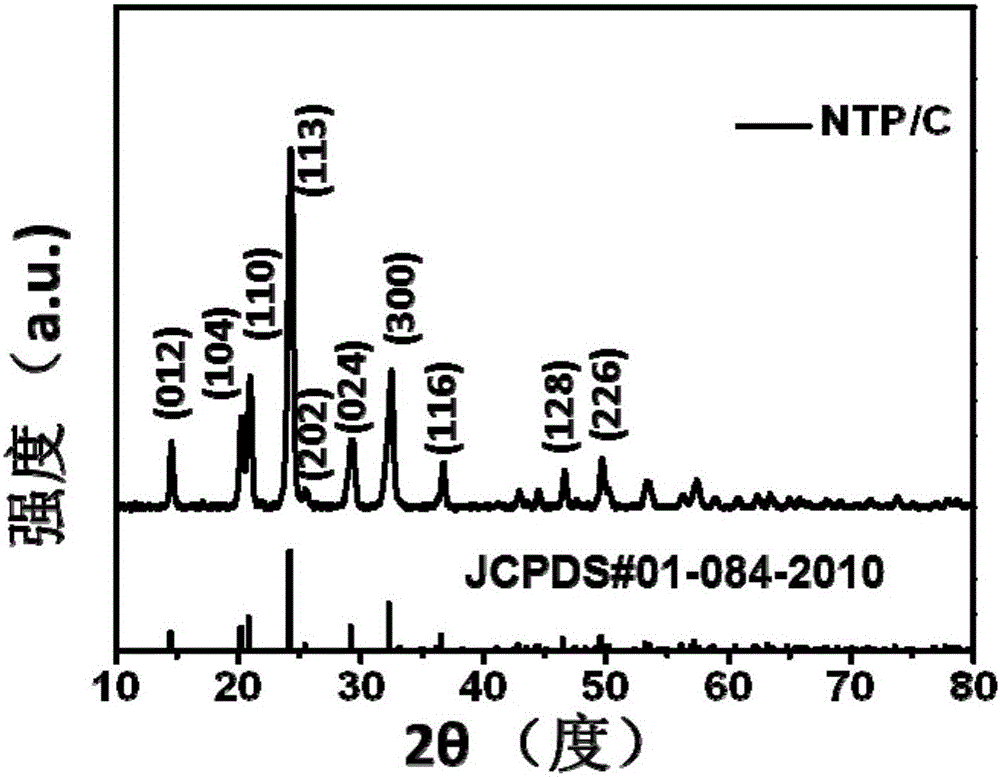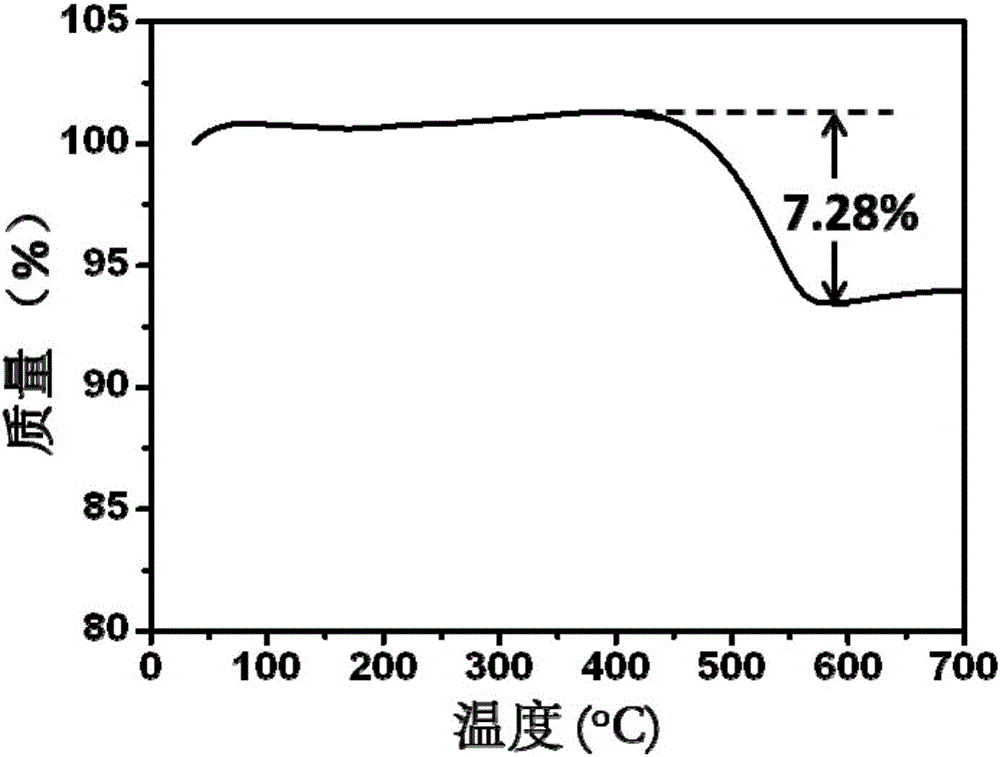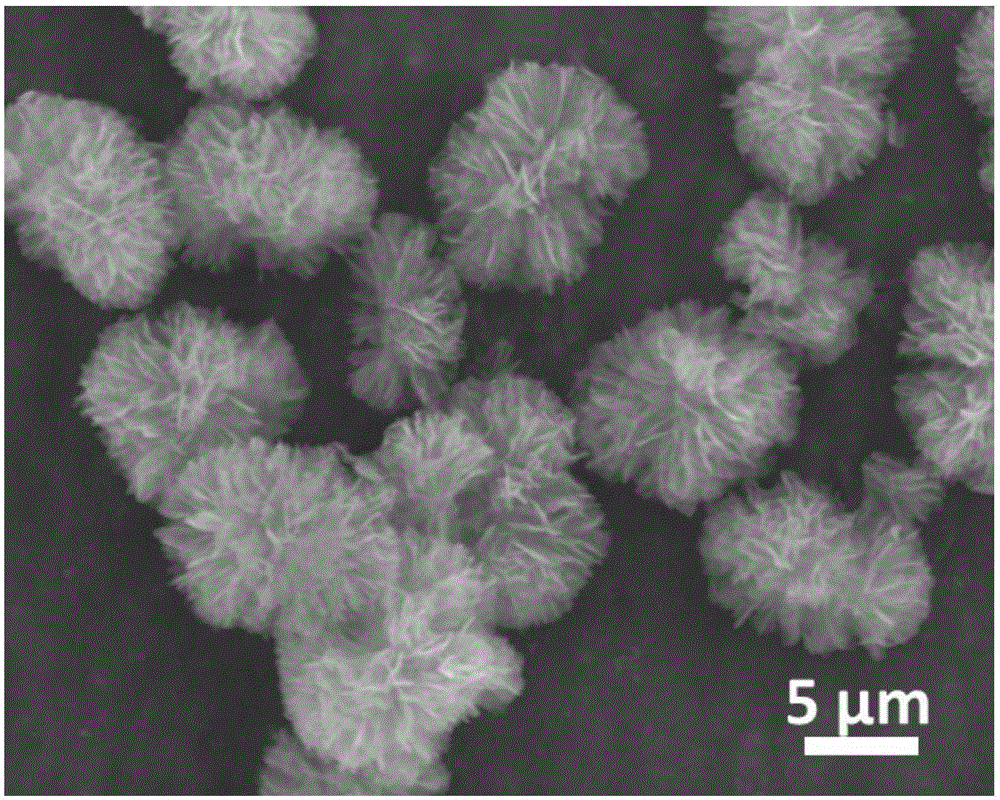Three-dimensional graded carbon-clad NaTi<2>(PO<4>)<3>/C micrometer flower electrode material and preparation method and application thereof
A carbon-coated, micro-flower technology, applied in the fields of nanomaterials and electrochemistry, to achieve the effect of expanding production, strong feasibility and high safety factor
- Summary
- Abstract
- Description
- Claims
- Application Information
AI Technical Summary
Problems solved by technology
Method used
Image
Examples
Embodiment 1
[0041] Three-dimensional hierarchical carbon-coated NaTi 2 (PO 4 ) 3 The preparation method of / C micron flower, it comprises the steps:
[0042] 1) Add 2 mmol of tetra-n-butyl titanate dropwise to 20 mL of ethylene glycol solution, and stir for 30 minutes to obtain a colorless and transparent solution;
[0043] 2) Weigh 1mmol of NaH 2 PO 4 2H 2 O was dissolved in 10mL deionized water, and was added dropwise to the solution obtained in step 1) and stirred evenly;
[0044] 3) Measure 2mmol of 85% phosphoric acid (H 3 PO 4 ) solution, which is dripped dropwise into the mixed solution obtained in step 2), and stirred evenly;
[0045] 4) Weigh 1 mmol of glucose as a carbon source and dissolve it in 10 mL of deionized water, then dropwise add it to the mixed solution obtained in step 3) and continue to stir for 1 hour to obtain a colorless and transparent solution;
[0046] 5) Transfer the mixed solution obtained in step 4) to a 50mL reaction kettle, react under hydrotherm...
Embodiment 2
[0053] 1) Add 1 mmol of tetra-n-butyl titanate dropwise to 30 mL of ethylene glycol solution, and stir for 30 minutes to obtain a colorless and transparent solution;
[0054] 2) Weigh 0.5mmol of NaH 2 PO 4 2H 2 O was dissolved in 5mL deionized water, and was added dropwise to the solution obtained in step 1) and stirred evenly;
[0055] 3) Measure 1mmol of 85% phosphoric acid (H 3 PO 4 ) solution, which is dripped dropwise into the mixed solution obtained in step 2), and stirred evenly;
[0056] 4) Weigh 0.5 mmol of glucose as a carbon source and dissolve it in 5 mL of deionized water, then dropwise add it to the mixed solution obtained in step 3) and continue to stir for 2 hours to obtain a colorless and transparent solution;
[0057] 5) Transfer the mixed solution obtained in step 4) to a 50mL reactor, react under hydrothermal conditions at 140°C for 24 hours, then cool to room temperature naturally, collect the product and place it in an oven at 120°C for direct drying...
Embodiment 3
[0062] 1) Add 4 mmol of tetra-n-butyl titanate dropwise to 40 mL of ethylene glycol solution, and stir for 30 minutes to obtain a colorless and transparent solution;
[0063] 2) Weigh 2mmol of NaH 2 PO 4 2H 2 O was dissolved in 10mL deionized water, and was added dropwise to the solution obtained in step 1) and stirred evenly;
[0064] 3) Measure 4mmol of 85% phosphoric acid (H 3 PO 4 ) solution, which is dripped dropwise into the mixed solution obtained in step 2), and stirred evenly;
[0065] 4) Weigh 3 mmol of glucose as a carbon source and dissolve it in 5 mL of deionized water, then dropwise add it to the mixed solution obtained in step 3) and continue to stir for 4 hours to obtain a colorless and transparent solution;
[0066] 5) Transfer the mixed solution obtained in step 4) to a 50mL reactor, react under hydrothermal conditions at 160°C for 15 hours, then cool to room temperature naturally, collect the product and place it in an oven at 120°C for direct drying to...
PUM
| Property | Measurement | Unit |
|---|---|---|
| Diameter | aaaaa | aaaaa |
| Thickness | aaaaa | aaaaa |
| Discharge specific capacity | aaaaa | aaaaa |
Abstract
Description
Claims
Application Information
 Login to View More
Login to View More - R&D
- Intellectual Property
- Life Sciences
- Materials
- Tech Scout
- Unparalleled Data Quality
- Higher Quality Content
- 60% Fewer Hallucinations
Browse by: Latest US Patents, China's latest patents, Technical Efficacy Thesaurus, Application Domain, Technology Topic, Popular Technical Reports.
© 2025 PatSnap. All rights reserved.Legal|Privacy policy|Modern Slavery Act Transparency Statement|Sitemap|About US| Contact US: help@patsnap.com



